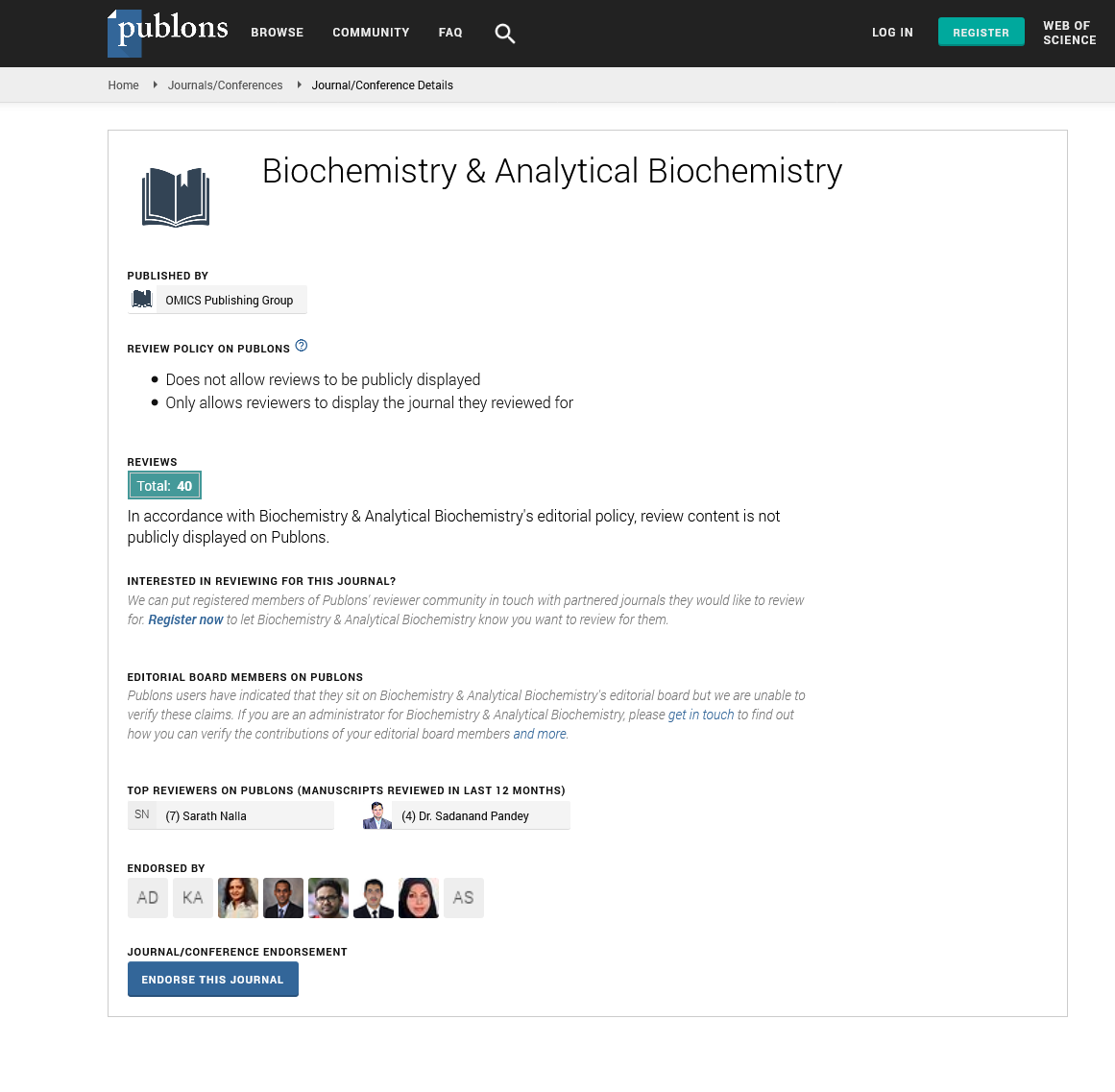Indexed In
- Open J Gate
- Genamics JournalSeek
- ResearchBible
- RefSeek
- Directory of Research Journal Indexing (DRJI)
- Hamdard University
- EBSCO A-Z
- OCLC- WorldCat
- Scholarsteer
- Publons
- MIAR
- Euro Pub
- Google Scholar
Useful Links
Share This Page
Journal Flyer

Open Access Journals
- Agri and Aquaculture
- Biochemistry
- Bioinformatics & Systems Biology
- Business & Management
- Chemistry
- Clinical Sciences
- Engineering
- Food & Nutrition
- General Science
- Genetics & Molecular Biology
- Immunology & Microbiology
- Medical Sciences
- Neuroscience & Psychology
- Nursing & Health Care
- Pharmaceutical Sciences
Commentary - (2025) Volume 14, Issue 2
Biochemical Pathways in Neurodegenerative Diseases: A Molecular Perspective
Thomas Keller*Received: 30-May-2025, Manuscript No. BABCR-25-29494; Editor assigned: 02-Jun-2025, Pre QC No. BABCR-25-29494 (PQ); Reviewed: 16-Jun-2025, QC No. BABCR-25-29494; Revised: 23-Jun-2025, Manuscript No. BABCR-25-29494 (R); Published: 30-Jun-2025, DOI: 10.35248/2161-1009.25.14.578
Description
Neurodegenerative diseases represent one of the greatest challenges of modern medicine, with biochemical research providing crucial insights into their underlying mechanisms. Conditions such as Alzheimer’s disease, Parkinson’s disease, Huntington’s disease, and Amyotrophic Lateral Sclerosis (ALS) are characterized by progressive neuronal loss and functional decline. Despite decades of research, effective treatments remain elusive, but advances in biochemistry and analytical biochemistry are gradually unraveling the molecular basis of these disorders.
A central feature of many neurodegenerative diseases is protein misfolding and aggregation. In Alzheimer’s disease, amyloid-beta peptides accumulate to form extracellular plaques, while tau proteins form intracellular tangles that disrupt microtubule stability. In Parkinson’s disease, alpha-synuclein aggregates into Lewy bodies, impairing synaptic function and dopamine signaling. Huntington’s disease is caused by abnormal expansions of polyglutamine repeats in the huntingtin protein, resulting in toxic aggregates. These protein aggregates are not merely byproducts but active contributors to cellular dysfunction, interfering with essential biochemical processes and triggering neuronal death.
Another major biochemical hallmark of neurodegeneration is oxidative stress. Neurons are particularly susceptible to damage from Reactive Oxygen Species (ROS) because of their high metabolic activity, reliance on mitochondrial function, and abundance of polyunsaturated fatty acids in membranes. Excessive ROS leads to lipid peroxidation, DNA damage, and protein oxidation, all of which compromise neuronal survival. Analytical methods such as redox-sensitive fluorophores and mass spectrometry-based detection of oxidative modifications have allowed researchers to map oxidative damage with increasing precision.
Mitochondrial dysfunction is a recurrent theme across multiple neurodegenerative diseases. Impaired ATP production, abnormal calcium handling, and release of pro-apoptotic factors are key events that compromise neuronal survival. For instance, studies in Parkinson’s disease have linked mitochondrial complex deficiency with dopaminergic neuron loss. In Alzheimer’s disease, dysfunctional mitochondria contribute to synaptic deficits long before clinical symptoms emerge. Understanding these biochemical disruptions offers therapeutic opportunities, as compounds that stabilize mitochondrial function are being investigated as potential disease-modifying treatments.
Neuroinflammation adds another layer of biochemical complexity. Microglia, the resident immune cells of the central nervous system, can release pro-inflammatory cytokines in response to protein aggregates and damaged neurons. While initially protective, chronic activation of microglia results in sustained inflammation that exacerbates neuronal injury. This interplay between biochemical signaling and immune pathways underscores the multifactorial nature of neurodegeneration.
Analytical biochemistry has been pivotal in identifying biomarkers for neurodegenerative diseases. Cerebrospinal fluid analysis has revealed altered levels of amyloid-beta, tau, and phosphorylated tau in Alzheimer’s disease, providing diagnostic and prognostic information. Blood-based biomarkers, though less developed, offer a promising avenue for non-invasive screening. Proteomic and metabolomic studies are further expanding the range of potential biomarkers, uncovering changes in lipid metabolism, neurotransmitter pathways, and energy production. These biochemical markers not only improve diagnosis but also provide tools for monitoring disease progression and treatment efficacy.
From a therapeutic perspective, the biochemical insights into neurodegeneration have driven efforts to target multiple pathways simultaneously. Antioxidants such as coenzyme Q10, mitochondrial stabilizers, and protein aggregation inhibitors have all been tested in clinical trials, though results have been mixed. More recently, approaches focusing on enhancing protein clearance mechanisms, such as the ubiquitin-proteasome system and autophagy, have gained attention. Gene editing technologies and RNA-based therapies also hold potential, offering ways to modulate the expression of disease-associated proteins.
One of the key challenges in translating biochemical knowledge into therapies lies in the complexity and redundancy of cellular pathways. Targeting a single pathway often produces limited benefits, as neurons rely on interconnected networks for survival and function. Systems biology approaches that integrate genomics, proteomics, and metabolomics with biochemistry are therefore essential to capture the full scope of neurodegenerative processes. Computational modeling further supports this effort, helping to predict how interventions will affect complex biochemical networks.
The societal burden of neurodegenerative diseases is immense, with aging populations worldwide driving a sharp increase in prevalence. Biochemical research offers hope by revealing the fundamental processes that underlie these disorders. By focusing on protein misfolding, oxidative stress, mitochondrial dysfunction, and neuroinflammation, scientists are gradually piecing together the puzzle of neurodegeneration. Analytical biochemistry ensures that these discoveries are not limited to the laboratory but can be translated into clinical biomarkers and therapeutic strategies.
Citation: Keller T (2025). Biochemical Pathways in Neurodegenerative Diseases: A Molecular Perspective. Biochem Anal Biochem. 14:578.
Copyright: © 2025 Keller T. This is an open access article distributed under the terms of the Creative Commons Attribution License, which permits unrestricted use, distribution, and reproduction in any medium, provided the original author and source are credited.

